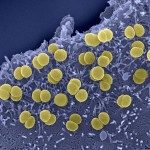Link to Pubmed [PMID] – 12492859
Mol Microbiol 2003 Jan; 47(1): 135-43
CrgA is a LysR-type transcriptional regulator involved in the intimate adhesion of Neisseria meningitidis to target human epithelial cells. It is negatively autoregulated, and its expression is transiently induced upon contact with target cells. We analysed the functional organization of CrgA using in frame deleted proteins. Four truncated proteins were constructed and purified. They were deleted between residues 20 and 40, 121 and 154, 111 and 181 and 268 and 291. Meningococcal mutants harbouring the corresponding deleted crgA alleles were also constructed. All mutants showed a reduced ability to adhere to epithelial cells. beta-Galactosidase activity assays using a crgA-lacZ transcriptional fusion showed that all the mutations except the 268-291 deletion resulted in loss of induction upon contact with target cells. Gel mobility shift assays and cross-linking assays showed that the oligomerization of CrgA is required for DNA binding and that the N-terminal part of CrgA is directly involved in DNA binding through a helix-turn-helix motif. The C-terminal region is also involved in DNA binding, probably by permitting the oligomerization of CrgA. The C-terminal region also seemed to interact with RNA polymerase. Therefore, the binding of CrgA and its interaction with RNA polymerase may inhibit the clearance of meningococcal promoters that are repressed by CrgA during the intimate adhesion of N. meningitidis to target cells.

